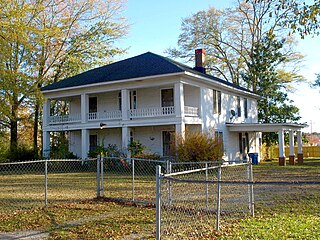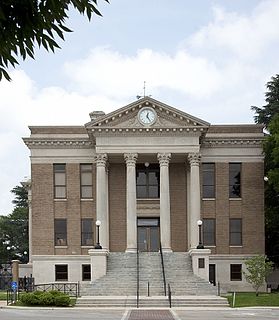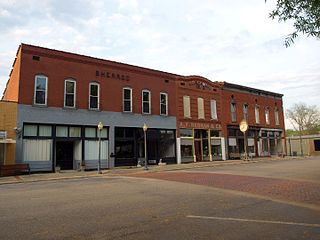
Huntingdon College is a private Methodist liberal arts college in Montgomery, Alabama. It was founded in 1854 as a women's college.

Snead State Community College is a public community college in Boaz, Alabama. It began as a private seminary in 1898 and became part of the Alabama Community College System in 1967. Snead awards associate degrees in 79 programs and certificates in 24 programs.

The Grove Hill Courthouse Square Historic District is a historic district in Grove Hill, Alabama. It is centered on the Clarke County Courthouse and the boundaries are roughly Cobb, Court, Jackson, and Main Streets. It features examples of Greek Revival and Queen Anne architecture. The district was added to the Alabama Register of Landmarks and Heritage on March 24, 1995 and to the National Register of Historic Places on April 30, 1998.

Fairhope Plantation is a historic Carpenter Gothic plantation house and historic district, located one mile east of Uniontown, Alabama, US. The 2 1⁄2-story wood-framed main house was built in the Gothic Revival style in the late 1850s. The plantation historic district includes six other contributing buildings, in addition to the main house. It was added to the Alabama Register of Landmarks and Heritage on December 19, 1991 and subsequently to the National Register of Historic Places on May 29, 1992, due to its architectural and historical significance.

The Alabama State University Historic District is a 26-acre (11 ha) historic district at the heart of the Alabama State University campus in Montgomery, Alabama. It contains eighteen contributing buildings, many of them in the Colonial Revival style, and one site. The district was placed on the Alabama Register of Landmarks and Heritage on August 25, 1994, and the National Register of Historic Places on October 8, 1998.

The Gainesville Historic District is a historic district that encompasses a historic section of Gainesville, Alabama, United States. The district was listed on the Alabama Register of Landmarks and Heritage on March 25, 1976 and the National Register of Historic Places on October 3, 1985. The district covered 76 acres (31 ha) and contained 24 historically significant contributing properties when first listed.

Oakhurst, also known as Winston Place and Mitchell Place, is a historic house in Emelle, Sumter County, Alabama. The two-story wood-frame house was built for Augustus Anthony Winston, a banker and cotton factor from Mobile, in 1854. The Greek Revival-style structure is five bays wide, with a one-story porch spanning the entire width of the primary facade. A bracketed cornice atop the entablature wraps around the entire house. It reflects the influence of the Italianate-style. This architectural combination, sometimes referred to as a "bracketed Greek Revival" style, was popular in Alabama from the 1850s to 1890s.

Flint River Place is a historic residence near Huntsville, Alabama. The house was built between 1844 and 1850 by Daniel Friend, a planter who came to Alabama from Kentucky around 1826. The house is Greek Revival in style, with Federal and Georgian Revival elements. It began as an L-shaped house, with an additional ell and one-story shed roofed infill built in 1930. The house is clad in poplar siding and the gable roof was originally slate over wooden shingles, but has been replaced by asphalt shingles. Two gable-end chimneys have simple, Federal-style mantels. The façade is three bays, with a one-story portico supported by four columns, with a balcony above; it replaced a gable-roofed, two-column portico in 1978. The main entrance is flanked by sidelights and topped with a fanlight. Windows on the entire house, except for the southeast bedroom addition, are six-over-nine sashes. The house was listed on the Alabama Register of Landmarks and Heritage in 1981 and National Register of Historic Places in 1982. The house was heavily damaged in a fire in 2012.

Greenlawn is a historic residence between Meridianville and Huntsville, Alabama. The house was built in 1849–50 by William Otey, replacing a log house built by his father in the early 1810s. Following William and his wife's deaths, the house was taken over by one of their granddaughters in 1907. Around 1925, the original Italianate portico was replaced with the current Greek Revival entrance, and a northern wing was added. The house fell vacant in 1963 and was later restored, now sitting at the entrance to a subdivision of the same name.

The New Market Historic District is a historic district in New Market, Alabama. The town was founded in the 1820s as a trade center along the road between Huntsville and Winchester, Tennessee. The town incorporated in 1837, and had grown to around 500 residents by the 1850s. Although much of the town was destroyed in the Civil War, some antebellum structures survive, including Classical Revival houses built in 1854 and 1860, and the Whitman-Cobb House built circa 1861.

The Thomas A. Snellgrove Homestead is a group of three historic residences and their outbuildings in Boaz, Alabama. The houses are the last remnants of the plantation settled by Billy Sparks in 1878. Sparks was one of the first white settlers in what is now Boaz. In 1886 the community was granted a post office and assumed its current name. Thomas A. Snellgrove married one of Sparks' granddaughters in 1895, and purchased the remnants of the plantation in 1898, one year after the town was incorporated.

The Attalla Downtown Historic District is a historic district in Attalla, Alabama. The city was founded in 1870 along the Alabama and Chattanooga Railroad. It quickly developed into a major iron ore export hub. After fires in 1887 and 1891, most of the frame buildings downtown were replaced with brick structures. The oldest buildings in the district, which date from the 1880s and 1890s, are built in Folk Victorian styles, with corbelled cornices and other decorative elements. Later buildings are in more plain Commercial Brick styles, while others were built in more academic styles, including the Art Moderne Etowah Theatre and the Colonial Revival Post Office building. The district was listed on the Alabama Register of Landmarks and Heritage in 2011 and the National Register of Historic Places in 2013.

The College Hill Historic District is a historic district in Scottsboro, Alabama. The neighborhood was the first subdivision to be platted in Scottsboro. The area takes its name from the Scott Male and Female Academy, which was built in 1878. The site has been occupied by schools since; the present building was constructed in the 1930s and currently houses the administration offices of the Scottsboro Board of Education. The district contains 14 houses, 10 of which were built between 1890 and 1929, three in the 1930s, and one in the 1970s. The earlier houses are primarily Vernacular styles, although the later construction includes Bungalow and English Cottage-style houses popular at the time. The district was listed on the Alabama Register of Landmarks and Heritage in 1982 and the National Register of Historic Places in 1983.

The Public Square Historic District is a historic district in Scottsboro, Alabama. Although Scottsboro had been the county seat of Jackson County since 1870, the town's earliest commercial development was centered on the Memphis and Charleston Railroad line, one block north of the square. After an 1881 fire along the rail line, some businesses began to rebuild around the square. Once the Tennessee Valley Authority brought prosperity to the region in the 1930s, development around the courthouse began to accelerate. The current Jackson County Courthouse was built in 1912 with matching Classical Revival porticos on two sides. Commercial buildings around the square are one or two stories and all of brick. While most are built in simple, lightly decorated commercial styles, some late 19th-century buildings have Victorian detailing. The district was listed on the Alabama Register of Landmarks and Heritage in 1981 and the National Register of Historic Places in 1982.

The Forest Home is a historic residence near Trinity, Alabama. The house was built in 1856 on land given to him upon his father-in-law's death. Davis was a farmer, a teacher at LaGrange College, and a leader of the Grange movement of farmer advocacy. The house remained in the Davis family as a working cotton farm until 1973. The house is a two-story I-house with a single-story rear ell. A two-story porch adorns the front façade. The house was listed on the Alabama Register of Landmarks and Heritage in 1979 and the National Register of Historic Places in 1980.

The Athens Courthouse Square Commercial Historic District is a historic district in Athens, Alabama. Athens was founded in 1818 when Robert Beaty and John D. Carroll began selling tracts of land. The following year, the town was chosen as the county seat of the newly formed Limestone County. Commercial development around the courthouse square was swift, aided by the strong cotton market. The town and courthouse suffered heavy damage during the Civil War in the Battle of Sulphur Creek Trestle. Athens' revival was slowed by major fires in 1882, 1894, and 1897, as well as the Panic of 1893. Redevelopment was spurred again in the 1910s and 1920s by a diversified economy with increased manufacturing, and in the 1930s by electricity provided by the Tennessee Valley Authority. Notable buildings in the district are the Limestone County Courthouse, built in 1919 in Neoclassical style with Palladian influences. The Old Post Office building was completed in 1933. The district was listed on the National Register of Historic Places in 1997 and the Alabama Register of Landmarks and Heritage in 2012.

The Courtland Historic District is a historic district in Courtland, Alabama. Courtland was founded in 1818 and incorporated the following year. Its location was chosen to be close to the Tennessee River to facilitate transportation, but also close to cotton plantations to the south. The town's founders envisioned becoming the county seat of the newly formed Lawrence County, but the title instead went to Moulton. Many of the earliest structures in Courtland were built of logs, and were later replaced with frame and brick buildings. Development plateaued by 1830, but received a slight bump from the Tuscumbia, Courtland and Decatur Railroad beginning in 1834. The oldest houses in the district date from this era, including the 1828 Federal-style John McMahon House and several I-houses.

The Wood Avenue Historic District is a historic district in Florence, Alabama. The residential neighborhood was primarily developed after Reconstruction, although five houses date from before the Civil War. By the time of Florence's economic boom of the 1880s, the most fashionable upper-class neighborhood in Florence, today known as the Sannoner Historic District, had already been filled in, leading development to move to Wood Avenue to the west. Most homes built during this time were large, Victorian structures, including many elaborate examples of Queen Anne architecture.






















